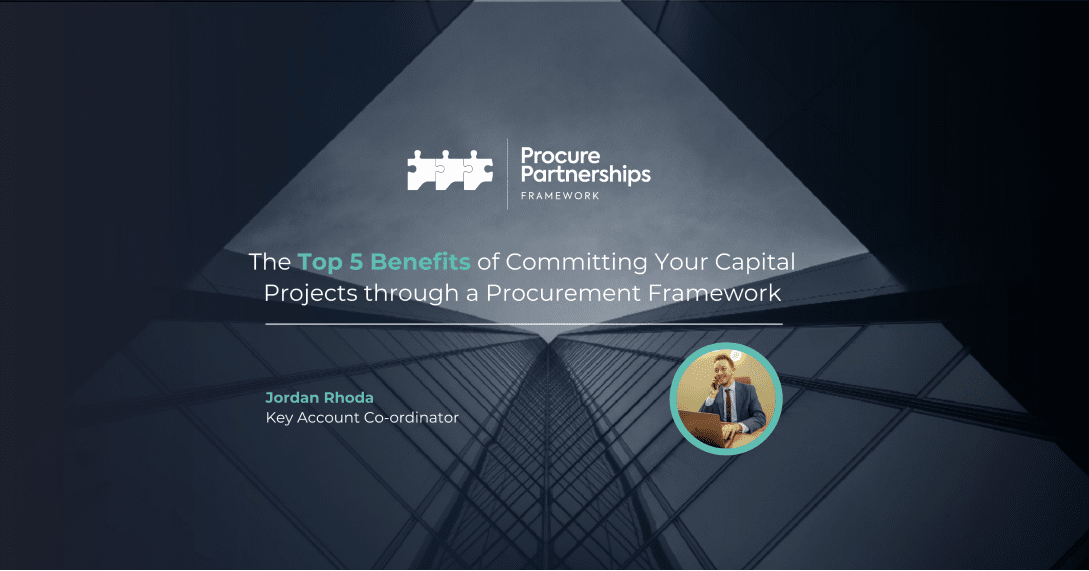UK construction contracts coming to market next year across public sector infrastructure are forecast to be worth £61 billion. The report conducted by industry intelligence provider Glenigan suggests this recovery is driven by the growth in health and industrial projects, increases in private and social residential activity, and a belated recovery in the hotel and leisure sector. To deliver the public services we all depend upon, the construction industry must find a way to deliver excellence in public works. This means developing a strategy to deliver better, faster, and greener solutions to support the Government’s levelling-up agenda and net zero by 2050 targets.
Key Account Coordinator Jordan Rhoda explores the top 5 benefits of committing your pipeline to a framework, so you can get your projects off to the right start!
A Robust Tender List
To avoid wasting time preparing and evaluating inappropriate bid responses, Authorities will issue a Pre-Qualification Questionnaire (PQQ) or Selection Questionnaire (SQ) to identify a shortlist of appropriate contractors to undertake the programme and they are then invited to tender. Clients will issue an Invitation to Tender (ITT) and tenders are evaluated against specified criteria to award the contract to a successful bidder. Two-stage tendering is a preferred project management procurement process to achieve a robust tender list. This method offers full flexibility and transparency for the sub-contracted tender lots. Contractors can submit bids based on an initial project design and compete for preferred contractor status.
In a collaborative approach, the pricing schedule and programme of work submission reduce the time and resources contractors need to complete the bid and mitigate risk. The preferred bidder moves to the second stage and the successful contractor is appointed under a Pre-Construction Services Agreement (PCSA), meaning that you sign a formal agreement to provide specified services. This agreement between the client and the contractor is to move forward with the project and is not a full design or fixed sum to conduct the work at this point. This method helps to attract enough interested suppliers to maintain a competitive process, securing a strong tender list.
Quality Tender Returns
Notification of projects coming to market early to inform contractors, giving them the opportunity to review the project scope, management, and overall criteria of the project, gives contractors visibility of the basic specifications required for the project’s design and build, and allows them to allocate bidding and pre-construction resources to the tender.
Giving contractors time to prepare and plan their submissions results in better-quality tender returns. Open communication and access to the project details early in the process also improve the retention rate of bidders throughout the exercise, making it less likely for suppliers to drop out. Having a pool of excellent-quality bidders to select from will ensure the successful contractor has the right qualifications and expertise to deliver the project to high standards.
An Effective Procurement Strategy
Successful project delivery is determined by key drivers throughout the project lifecycle, the main three being cost, time, and quality. These factors are heavily influenced by your procurement strategy, so it is important to ensure it is effective and meets the needs of the individual project. Through early market engagement, a range of benefits are achieved that help form an effective procurement strategy for the long term.
This soft market test to share information about the project with the market is to understand the level of interest and capability in a broad sense, rather than an individual contractor’s capabilities. Understanding the market and what is needed to best improve project outcomes gives a clearer perspective on the procurement activities required to select the right contractor. The earlier strategic information about the project is communicated to the market, the more opportunity this creates for contractors of all sizes and across all levels of the supply chain.
By communicating an upcoming project opportunity by releasing project information, consultation is initiated ahead of the tender release, and discussions can focus on project outcomes rather than project scope. This supports innovation and best value, aiding the delivery of solutions that best drive social value, net zero, and sustainability objectives. By planning and issuing projects to the market early, clients have a better insight into what their tender lists will look like, affording adequate time to revise the procurement strategy should market interest be insufficient.
Commercial Advantage
A highly effective method of public sector procurement is batching projects together for a programme of work. By committing your pipeline of projects to a public sector framework, multiple projects can be underway synchronously and batching allows for one contractor to deliver more than one work or service at a time, maximising buying power from the supply chain.
Batching multiple smaller projects into one consolidated programme of works enables a contractor to analyse what resources are needed on site and coordinate the workforce to reduce the number of different teams required throughout project delivery, reducing overheads. Batching allows for a tactical procurement strategy where prelims—materials and equipment—can be shared across project sites, reducing deliveries and consequently the project’s carbon footprint.
The ability to combine orders for materials improves buying power and allows contractors to deliver better value to their clients within their call-off contracts. Consolidating the procurement of materials and equipment needed for batched projects means larger quantities can be ordered and better pricing can be negotiated, whether this be in the private sectors, large-scale companies, etc.
This ability to scale up ensures procurement teams are not duplicating work and the materials can be sourced from suppliers who offer the best value in terms of price, quality, and delivery. Overall, batching is an extremely effective way of gaining a commercial advantage.
Market Insight
Using a procurement framework agreement gives the contractor market plenty of time to engage with new opportunities released, allowing for informal soft market testing sessions to take place that allow clients and contractors to ask each other questions ahead of the official tender release.
These invaluable discussions give contractors a general understanding of what the project includes when planned and executed, and they give the client an insight into the capabilities of the market to help shape and inform the procurement strategy and project plan. Central to all procurement routes and the tendering process is the overarching principle of delivering a project’s strategic targets.
Procure Partnerships Framework is a dedicated and specialist construction framework, supporting public sector bodies to deliver their key objectives and their social value and environmental commitments. Our industry experience and in-depth knowledge of UK procurement regulations allow us to deliver value, flexibility, and successful partnerships for both clients and contracting authorities alike.



